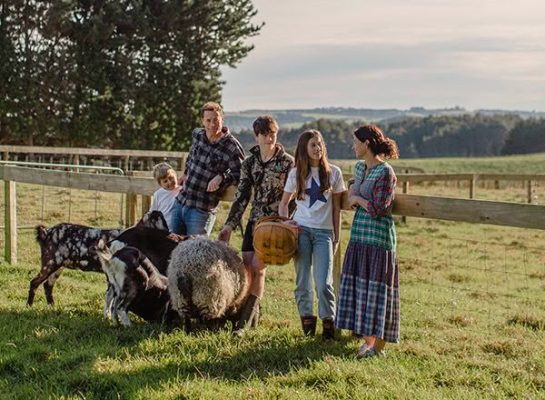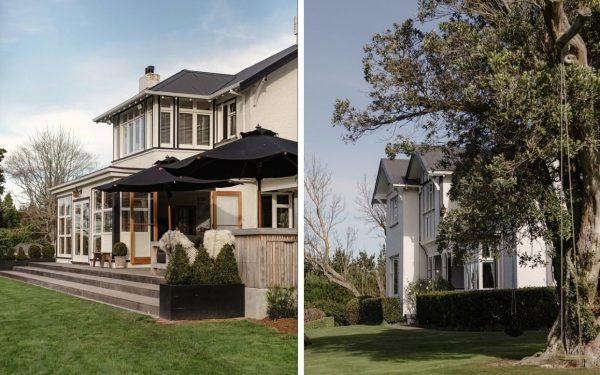The Rhythm of Nature
Drawing on their natural surrounds, Ben and Vanessa Dickie have combined enterprise and environmental stewardship to share their slice of heaven with others, creating a lifestyle that is perfectly in tune with their natural backdrop and values. Words Lucinda Diack, Photos Alanah Brown.

Vanessa (Ness) Dickie laughs loudly as she recalls moving from the hustle and bustle of Sydney to the depths of Taranaki’s dairy country. ‘I arrived in my pink gumboots, naïve about where water comes from (turns out you can’t always just turn the tap and expect it to flow) and lots of enthusiasm … until the bobby calves left on a truck; then there were tears.’
Born on a sheep farm in Hawke’s Bay where she lived until she was nine – when country life was replaced with city living – Ness has come full circle, back to a life she had loved when she was little.
‘After university I worked at an advertising agency in Auckland,’ describes Ness. ‘I met Ben when he was there working in finance and we travelled, lived the big-city life, even moved to Sydney. I never thought I’d end up back on a farm.’ But despite the emotions, the challenges and the life lessons, she hasn’t looked back, forging a covetable life in picturesque Waverley.
For Ben, growing up as the youngest of three on a generational dairy farm, working the land was in his blood. ‘I came and went from the farm over the years, working here during university holidays but didn’t really think I would come home full-time,’ he reflects.
‘Some of my friends thought I was mad, but I loved it. Being able to have chickens, grow our own food and raise our children here, it doesn’t get much better, but it was hard.’

When the opportunity presented itself in 2005, the couple jumped in the deep end, moving from Sydney to a farm cottage to support Ben’s parents Heather and John when health got in the way. ‘Due to health reasons Dad retired quite quickly which probably made the transition easier than it might have been,’ says Ben, ‘as we just had to get on with it.’
‘It was quite a transition,’ says Ness with a smile. ‘Some of my friends thought I was mad, but I loved it. Being able to have chickens, grow our own food and raise our children here, it doesn’t get much better, but it was hard. We had jumped into the deep end of dairy farming and then decided to have three children – it was busy!’
Any parent reflecting on this period of life will understand the emotions, an exhausted whirlwind of ‘how did we do it’ moments that Ness and Ben would have faced in those early years. But it was also a period that gave the couple time to understand the farm systems, identify what worked – and didn’t work – and where their strengths lay. ‘We made the decision a few years ago to bring contract milkers on farm,’ explains Ness, which freed the couple up to explore other ventures and bring diversification to the farm.
‘Dad has always been really entrepreneurial,’ explains Ben. ‘When we were kids he had a pet-food business, he ran deer, he had an ability to change and pivot that allowed him to still farm and survive, and it was his excitement about what we were thinking that gave us the confidence to explore things further.’
The dairy downturn of 2014, along with the ever-increasing environmental constraints on farming in New Zealand forced Ness and Ben to consider diversification on a greater scale. ‘There were lots of options out there,’ shares Ben, ‘but we wanted something that spoke to us, that would fit with our family and values and have the potential to reduce the environmental impact of our cows.’ Which is how they came across mānuka.

‘Ben had come across research by Plant and Food that assessed the benefits of mānuka oil and where the best varieties came from,’ says Ness. ‘Mānuka plants from the East Cape have the highest concentrations of the desired active compounds. The question was, would they thrive and have the same properties in our West Coast environment?’
‘So we foraged some seed from the side of the road and planted them,’ explains Ben. ‘It was successful, but it wasn’t an efficient way to grow our crop, so we enlisted the help of a nursery.’
And the rest, as they say, is history.
Setting aside eight hectares, the couple now have around 15–20,000 mānuka trees per hectare. That’s nearly 160,000 trees. ‘I remember when we planted the first ones from the nursey and saying, “Let’s just see if they will grow,”’ says Ben with a smile. ‘And they did.’
‘I remember when we planted the first ones from the nursey and saying, “Let’s just see if they will grow,”’ says Ben with a smile. ‘And they did.’
‘Planting the trees is truly hilarious,’ says Ness. ‘We use an old lettuce planter and sit there feeding the seedlings into the back of it while Ben drives the tractor. We plant in winter and then the trees get their first harvest 18 months later. Which is really like undertaking a giant hedging project, and then the trees regenerate from there.’
Ben had the first oil samples tested in the US. The results revealed the oil had the high levels of triketones (chemical antibacterial and anti-fungal properties) they needed to take their vision to the next level.
Every 12 months the trees can be harvested for oil. Essentially cutting the tree at a certain height, a harvester strips the branches of its leaves, mulching the unwanted wood and collecting the leaves to be transferred into a stainless-steel still, which extracts the oil using steam, heat and a vacuum system. ‘At first we thought we would just make and then sell the oil to a cosmetic manufacturer,’ explains Ness. ‘But as we did more research, we found a gap in the market.’
Active relaxers, the Dickies are often found up mountains, running, biking, skiing and hiking. ‘We kept looking for great natural products that could keep up with the harsh conditions and our love of the outdoors,’ says Ben. ‘When we couldn’t find them, we decided we could use our mānuka oil to make our own.’

Ben and Harry inspecting the mānuka. The trees can be harvested every 12 months for their oil.
With her experience in design and advertising, Ness relished the opportunity to create something that spoke to her personally. ‘When we started That’s It, it was about making the kind of products we want to see in the world – thoughtfully considered, natural, and made with an uncompromising commitment to sustainability and quality,’ she says. ‘We wanted products that we would use, that really worked. That did what they said they would.’ Products like their First Aid Gel, a 100 per cent natural antiseptic, that has been used and enthused over by customers for everything from chafing to cuts, burns, bites and even eczema.
While the products are made by a manufacturer in Auckland, everything else is done on farm. ‘We are proud to be showing our kids that enterprise and environmental stewardship can combine to create the best of all worlds,’ says Ness. ‘It is a real buzz to know that we are replanting the very native trees that were once cleared from the whenua and helping to revitalise our small patch of paradise.’ Continuing the circular nature of the trees is the mulch, which Ness uses in the garden.
‘We literally live off the land, so it is important to me that we respect nature and her rhythms.’
Alongside their entrepreneurial venture into mānuka oil products, Ness has managed to forge her own career on the farm with what Ben lovingly refers to as her ‘fancy grey sheep’.

‘I wanted to have something of my own, that was fun but that would allow me to contribute to the farm,’ enthuses Ness, ‘so I bought eight Gotland sheep.’ Attracted to them for their uniqueness and their beautiful dark grey wool, Ness laughs as she tells me she is a vegetarian but word on the street is that their meat is delicious.
Ness’s flock has now grown to 100 – ‘or well over that’ if you are asking Ben – and she has fine-tuned her breeding, utilising Swedish Gotland genetics to ensure the wool is silkier and more silvery-grey than black.
As Ben discovered, shearing Gotland sheep is no easy feat, with their fleece more like mohair than traditional white wool (‘and worth even less’), but it is their pelts that Ness is particularly interested in. ‘We literally live off the land, so it is important to me that we respect nature and her rhythms. We believe in honouring the animals we raise by making sure – when it’s time – we waste as little as possible of their gifts. It is from living this philosophy that Three Sticks Gotland Sheepskins was born.’

As if balancing the busy life of three children, a farm and two businesses wasn’t enough, Ben and Ness have lovingly renovated the 105-year-old home they live in and its expansive surrounds. As the fifth generation on the farm, the 1919 homestead boasts an expansive history, one that Ness and Ben wished to honour. ‘We moved into the house in 2010 and over the years have made our mark on it,’ describes Ness. From sanding and staining the wooden floors to adding radiators for warmth, and transforming the old office above the garage into a teenage haven.
They have also sympathetically renovated the lounge, adding inbuilt bookshelves in heart rimu. ‘We wanted them to look as though they have always been there.’ A desire they have well and truly achieved – this is a room designed for curling up in with a good book.
Added by Ben’s grandparents, the sunroom has been enhanced further with the addition of doors, creating a seamless connection between inside and out. ‘It was always our dream to have a big deck out there,’ says Ness, ‘and finally this has come true in the last year.’ With Ben teaching himself how to build (via YouTube) and weld steel to execute the vision.
As if balancing the busy life of three children, a farm and two businesses wasn’t enough, Ben and Ness have lovingly renovated the 105-year-old home they live in and its expansive surrounds.
Outside, the expansive lawn provides endless scope for imagination for children – and half a day on the ride-on mower to keep it under control.

Like the rest of the home, the landscaping feels authentic, like it has always been this way, yet it is once again a showcase and testament to the couple’s sympathetic and dedicated consideration to design. ‘In 2013, three years after we moved into the house we had a massive storm,’ shares Ness. ‘It blew roofs off sheds, destroyed others, blew out a shelterbelt that ran around the house and took out 100-year-old trees. So, while some of the older trees remain, we were forced to restart much of the garden.’
Ness recalls crying for weeks about the devastation. ‘What Ben’s mum Heather, and the generations prior, had achieved and built in the garden was beautiful. It was just glorious and to lose most of it in the storm … it was a lot.’
While the couple still love heading to the big smoke to visit friends, living life to the rhythm of nature and all that it brings in rural Aotearoa is what life is all about now, and Ness wouldn’t have it any other way. ‘I just love it.’

